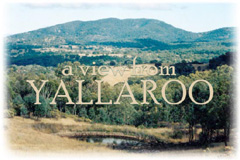
Expatriate Plants
Warren and Gloria Sheather
In the early days of European settlement a surprising number of Australian plants found their way overseas. Many were herbarium specimens but there were also living material and seeds.
| |
| A View from Yallaroo |

Gloria and Warren are passionate about the cultivation, conservation and propagation of Australian native plants and this translates into their very comprehensive and informative web site.
The purpose of the web site is to communicate information about their horticultural activities, describe the wildlife visiting Yallaroo, research into propagation methods and delve into environmental topics including descriptions of Australian National Parks and other reserves.
Well worth a look.....
|
|
We have noticed that some species were exported and cultivated before they were given scientific names. There were a number of these "expatriate" plants that were named from specimens growing overseas and sometimes these names refer to overseas locations rather than an Australian context.
Eucalyptus camaldulensis, the River Red Gum, is probably the most widespread eucalypt in Australia. The species was named in 1832 and refers to Camalduli, a district in Tuscany, Italy. River Red Gums were planted in a garden in that district.
Eucalyptus moluccana, the Grey Box, was named after the Moluccas in Indonesia. Grey Box was planted in those islands before the official naming, also in 1832. Eucalyptus moluccana is a medium tree with tessellated, light grey bark. We used to collect Grey Box along the Waterfall Way, east of Armidale for Botany practical classes at the University of New England.
Eucalyptus pulverulenta, the Silver-leaved Mountain Gum, is a rare species with limited distribution in New South Wales. The species was named by John Sims in England in 1819. Seed was probably collected in 1815 when Governor Macquarie first journeyed across the Blue Mountains. Eucalyptus pulverulenta was not officially discovered until 1825 and was named Eucalyptus pulvigera by Cunningham because he was unaware of the earlier naming. The silver-leaved Gum is considered vulnerable in the wild but is coming into cultivation. It is a tall shrub or rather straggly small tree with silvery-blue, almost circular juvenile leaves. Adult leaves rarely put in an appearance. The species name means covered with powder and refers to the bloom on the foliage.
Acacia mearnsii was named in 1925 after E. A. Mearns who collected the type specimen from a cultivated plant in East Africa. This species, together with other wattles, was probably used in the production of tan bark. Acacia mearnsii is a tall, attractive species with bipinnate foliage and yellow globular flowers. Blooms appear in summer after most other wattles have finished flowering. It is found in New South Wales, Victoria, South Australia and Tasmania.
From 'Native Plants for New South Wales', the newsletter of the Australian Plants Society (NSW), April 2008.
Australian Plants online - 2008
Association of Societies for Growing Australian Plants
|